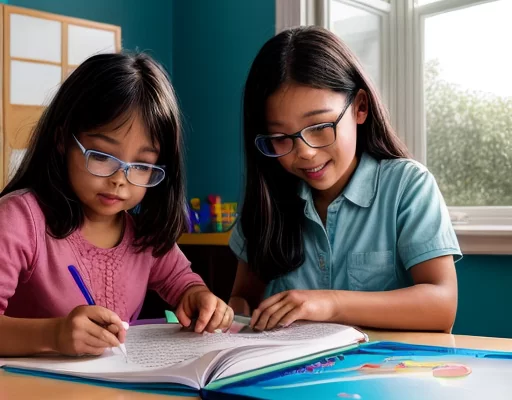
Creating Memorable Learning Experiences at Home
“`html
Creating Memorable Learning Experiences at Home
Introduction
Education is not confined to the walls of a classroom; a child’s home is also a powerful environment for learning and exploration. As parents and caregivers, you have the unique opportunity to create memorable learning experiences that not only educate but also bond and delight your family. In this comprehensive guide, we will explore various strategies and tips to engage children in productive and enjoyable learning activities at home.
Understanding Your Child’s Learning Style
Every child is unique and so is their learning style. Some children are visual learners, while others are auditory or kinesthetic. It is essential to observe how your child interacts with the world around them and tailor your approach to their preferences. This could mean creating colorful visual aids, incorporating music and stories, or engaging in hands-on projects.
Creating a Conducive Learning Environment
The physical space where your child learns can significantly affect their ability to absorb information. Setting up a dedicated learning area that is organized, well-lit, and free of distractions can make a big difference. Equip this space with all the necessary supplies and, if possible, allow your child to personalize it to make it their own.
Incorporating Play in Learning
Play is a fundamental aspect of learning, especially for younger children. Incorporating educational games, puzzles, and activities can make learning more enjoyable. When children play, they develop critical thinking, problem-solving, and social skills that are crucial for their overall development.
Choosing the Right Educational Toys
Not all toys are created equal when it comes to educational value. Select toys that challenge your child’s intellect and creativity, like construction sets, science kits, and craft materials. These toys can help build vital skills and keep the learning process engaging.
Interactive Play Techniques
Interaction is key to play-based learning. Join in on the fun by guiding your child through activities, asking thought-provoking questions, and encouraging them to explore further. This active participation not only enhances the learning experience but strengthens your bond with them.
Integrating Technology Wisely
Technology can be a double-edged sword. While it offers incredible resources for learning, it also has the potential to be distracting. Wisely integrate technology by using educational apps and online resources that are interactive and tailored to your child’s educational needs. Always supervise your child’s screen time to ensure it remains a valuable tool for learning.
Balancing Screen Time
While screens can provide engaging learning content, it’s crucial to balance screen time with offline activities. Too much screen time can lead to a sedentary lifestyle and impact attention spans. Create a schedule that allows for diverse experiences, including reading, arts and crafts, and outdoor play.
Curating Educational Content
Carefully select and curate the content your child consumes online. Highly educational programs, apps, and websites can reinforce concepts taught in school or introduce new topics in an interactive way. Read reviews and explore these resources yourself to ensure they meet your educational standards.
Exploring the World Through Books
Reading is fundamental to learning, and creating a culture of reading at home can inspire a lifetime of exploration and discovery. A home library, a comfy reading corner, and a routine around bedtime stories or family reading time can encourage a love for literature and improve literacy skills.
Making Reading Interactive
Make reading an interactive experience by discussing the stories with your child, asking them questions, and encouraging them to express their thoughts and predictions. This not only improves comprehension but also develops critical thinking and communication skills.
Expanding Beyond the Page
Take the learning experience beyond the page by relating stories to real-life experiences. If a book is about space, plan a visit to a local planetarium or do a hands-on space project. These connections between books and the real world make learning vivid and memorable.
Encouraging Expression through Art
Art is an expressive outlet that allows children to communicate their feelings and ideas. Provide a variety of art supplies and give your child the freedom to create. This promotes creativity, fine motor skills, and can serve as a springboard for other learning activities.
Integrating Art with Other Subjects
Art can be integrated with other subjects to deepen understanding. For instance, draw or paint a scene from a historical event or build a model of a cell. These artistic endeavors help children synthesize information in new and imaginative ways.
Art Appreciation and History
Introduce your child to art appreciation by exploring the works of famous artists and different art movements. Discussing the historical context and techniques used by artists enhances cultural awareness and analytical skills.
Fostering Curiosity with Science Experiments
Science experiments are not just educational, but they can also be incredibly fun. Conduct simple experiments at home using household items to awaken curiosity and explain complex scientific principles in a way that’s relatable and exciting.
Safe and Educational Experiments
Always ensure that the experiments conducted at home are safe. Choose age-appropriate experiments and supervise them closely. There are many resources available online with step-by-step instructions for educational and fun science activities.
Connecting Science to Everyday Life
Connect scientific principles to everyday phenomena. For example, baking can become a lesson in chemical reactions, or gardening can illustrate the cycle of plant life. These connections make science relevant and easier to comprehend.
Learning through Cooking and Baking
Involve your children in cooking and baking as a way to learn about measurements, chemistry, and nutrition. Following recipes can improve reading and math skills, while the sensory experience of preparing food can be a delight, making learning practical and deliciously rewarding.
Conclusion: The Joy of Learning Together
Crafting memorable learning experiences at home is about enhancing education with joy and curiosity. These moments are not just beneficial for intellectual growth but are treasured memories that strengthen family bonds. By observing your child’s interests and being a guide in their learning journey, you create a nurturing environment where education is a shared adventure.
“`

